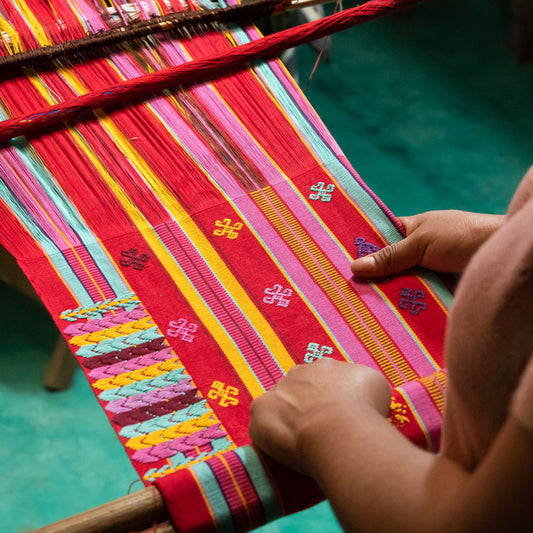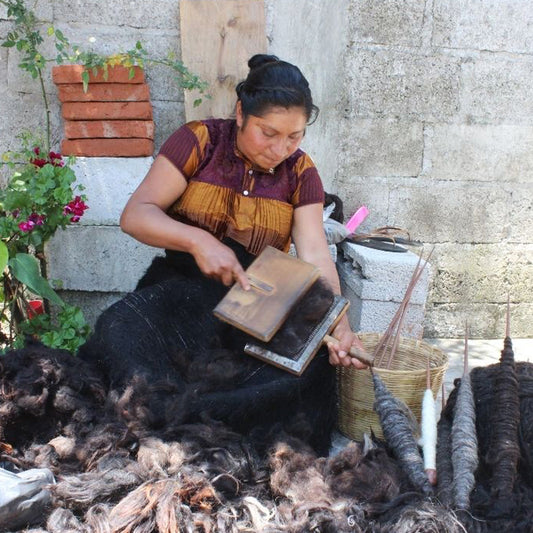When shopping for sustainable jewellery, you’ve likely seen the terms “recycled jewellery” and “upcycled jewellery” thrown into the mix. But what is recycled jewellery, and why is it more environmentally friendly than jewellery made using virgin materials?

Recycling vs. upcycling
Whilst both methods reuse existing materials, there is a slight distinction between the two processes. Recycled jewellery is where a material is broken down into its raw form and remoulded into something new. For example, gold can be melted down into molten gold and poured into a new mould.
Upcycling, on the other hand, is where part or whole of an object is creatively reused in its existing form. For example, collecting glass fragments from the beach and turning them into a beaded necklace.
Why choose recycled jewellery?
Upcycling and recycling are critical ways we can reduce our environmental and social impact when buying jewellery. To break it down, let’s take a look at the processes needed to make virgin jewellery – both cheap and expensive. Mining for precious metals and stones comes at a huge environmental cost. According to Diamond Foundry, an above ground man made diamond company, 143 pounds of carbon dioxide is released into the air for each carat of natural diamond mined industrially. In addition to this, irresponsible sourcing can involve child labour, wildlife displacement, human trafficking, water pollution, armed violence and the violation of indigenous peoples’ rights. Made well, the resulting jewellery can last for years, very slightly mitigating these environmental and social consequences. Made poorly – i.e. jewellery you find in fast fashion stores – and it will most likely end in landfill. All that time, energy and destruction for nothing.
In contrast, recycled and upcycled jewellery takes “unwanted” resources – what we see as “waste” – and transforms them into something new and valuable. Not only does this prevent this waste from ending in landfill, but it reduces the need to mine for raw materials – thus avoiding the environmental and social complications above.
SOUL Design: A sneak peak into the recycling process

Based in South Africa, SOUL Design strives to make their jewellery as responsible and cyclical as possible by using recycled brass across their range: “brass is the main material in our jewellery design. Our Kenyan brass-smiths work by melting down unwanted brass pieces (padlocks/old jewellery etc) and then re-imagine them into our beautiful SOUL Design pieces.”
To rework the salvaged brass, the brand uses traditional brass-smithing techniques, mainly hand-cutting the pieces to break it down. This is then melted in a small traditional wood burning furnace. Moulds are made from molasses and wax casting. And minimal bunsen burner fire is used for soldering. “These are all environmentally very low impact, traditional jewellery making techniques that have been used for centuries. They also only cater for small-scale production.”
The result is high quality craftsmanship that is not only beautiful, but ethical, sustainable, and will stay with you for years to come.
“Our all-time favourite pieces are our classic Tuareg Bangle and Savannah Hoops - both pieces work so well with every outfit!”
Other recycled jewellery brands for your radar
Pichulik
Based in South African, Pichulik stands out for their innovative use of repurposed cotton rope. Each piece is made by a single artist, who reworks the rope into unique sculptural shapes and embellishes them with cast and exotic materials.
Lilabare
Made by artisans in Kenya, Lilabare’s track necklace range is made from 100% recycled brass. The prints are cast from real footprints found in the Maasai Mara’s Olare Motorogi conservancy. For every necklace sold, an indigenous seedling is planted into the conservancy.
Dear Katiopae
Working with artisans in Ghana, Kenya and the Ivory Coast, Dear Katiopae uses the artisanal technique of lost wax to melt down brass or bronze for their jewellery. Lost waxing is an ancient method where molten metal is poured into a wax mould. The wax patterns can be reclaimed and reused, making it a circular and environmentally friendly process.
Meraki Designs Jewellery
Meraki’s jewellery is handmade using recycled brass, sterling silver and ethically sourced raw stones. Each piece is handmade with skill and care, embracing natural imperfections and staying true to the beauty of the materials used.
It can be easy to forget about jewellery when we make the shift to buying more responsibly. But just like our clothing, how it’s made and what it’s made from have big consequences on both people and planet. Buying recycled jewellery – and recognising the value in waste more generally – is a quick and simple step anyone can make to reduce their impact on our ecosystems and ensure their shopping decisions are that little bit greener.
Looking for ethical and sustainable jewellery? We vet all the brands in our Jewellery range so you don’t have to. Check out our collections here.



